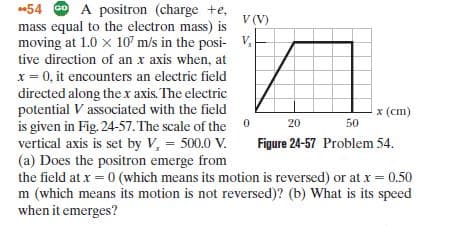54 0 A positron (charge +e, mass equal to the electron mass) is moving at 1.0 x 107 m/s in the posi- V. tive direction of an x axis when, at V (V) x = 0, it encounters an electric field directed along thex axis. The electric potential V associated with the field is given in Fig. 24-57. The scale of the 0 vertical axis is set by V, 500.0 V. (a) Does the positron emerge from the field at x = 0 (which means its motion is reversed) or at x = 0.50 m (which means its motion is not reversed)? (b) What is its speed when it emerges? x (cm) 20 50 Figure 24-57 Problem 54.
54 0 A positron (charge +e, mass equal to the electron mass) is moving at 1.0 x 107 m/s in the posi- V. tive direction of an x axis when, at V (V) x = 0, it encounters an electric field directed along thex axis. The electric potential V associated with the field is given in Fig. 24-57. The scale of the 0 vertical axis is set by V, 500.0 V. (a) Does the positron emerge from the field at x = 0 (which means its motion is reversed) or at x = 0.50 m (which means its motion is not reversed)? (b) What is its speed when it emerges? x (cm) 20 50 Figure 24-57 Problem 54.
Principles of Physics: A Calculus-Based Text
5th Edition
ISBN:9781133104261
Author:Raymond A. Serway, John W. Jewett
Publisher:Raymond A. Serway, John W. Jewett
Chapter19: Electric Forces And Electric Fields
Section: Chapter Questions
Problem 31P
Related questions
Question

Transcribed Image Text:54 0 A positron (charge +e,
mass equal to the electron mass) is
moving at 1.0 x 107 m/s in the posi- V.
tive direction of an x axis when, at
V (V)
x = 0, it encounters an electric field
directed along thex axis. The electric
potential V associated with the field
is given in Fig. 24-57. The scale of the 0
vertical axis is set by V, 500.0 V.
(a) Does the positron emerge from
the field at x = 0 (which means its motion is reversed) or at x = 0.50
m (which means its motion is not reversed)? (b) What is its speed
when it emerges?
x (cm)
20
50
Figure 24-57 Problem 54.
Expert Solution
This question has been solved!
Explore an expertly crafted, step-by-step solution for a thorough understanding of key concepts.
This is a popular solution!
Trending now
This is a popular solution!
Step by step
Solved in 3 steps with 3 images

Recommended textbooks for you

Principles of Physics: A Calculus-Based Text
Physics
ISBN:
9781133104261
Author:
Raymond A. Serway, John W. Jewett
Publisher:
Cengage Learning

Physics for Scientists and Engineers with Modern …
Physics
ISBN:
9781337553292
Author:
Raymond A. Serway, John W. Jewett
Publisher:
Cengage Learning

Physics for Scientists and Engineers
Physics
ISBN:
9781337553278
Author:
Raymond A. Serway, John W. Jewett
Publisher:
Cengage Learning

Principles of Physics: A Calculus-Based Text
Physics
ISBN:
9781133104261
Author:
Raymond A. Serway, John W. Jewett
Publisher:
Cengage Learning

Physics for Scientists and Engineers with Modern …
Physics
ISBN:
9781337553292
Author:
Raymond A. Serway, John W. Jewett
Publisher:
Cengage Learning

Physics for Scientists and Engineers
Physics
ISBN:
9781337553278
Author:
Raymond A. Serway, John W. Jewett
Publisher:
Cengage Learning

College Physics
Physics
ISBN:
9781938168000
Author:
Paul Peter Urone, Roger Hinrichs
Publisher:
OpenStax College

Physics for Scientists and Engineers, Technology …
Physics
ISBN:
9781305116399
Author:
Raymond A. Serway, John W. Jewett
Publisher:
Cengage Learning

College Physics
Physics
ISBN:
9781285737027
Author:
Raymond A. Serway, Chris Vuille
Publisher:
Cengage Learning